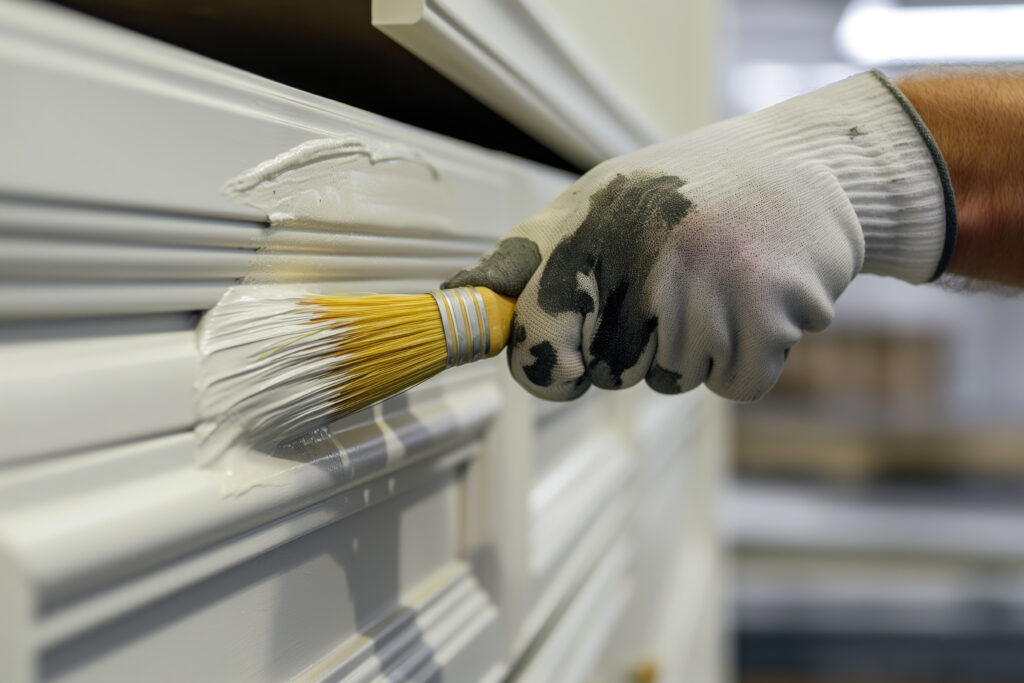Shoutout to all the DIYers out there! To all the measure-twice, cut-once kings, to those who know to work smarter, not harder, and to all who recognize that every expert once started out as just a beginner. A DIY project can take guts, so kudos for taking that leap!
Tackling a “Do-It-Yourself” project can be intimidating for beginners, but those who are willing to take that leap and learn can reap major benefits. DIY projects are great whether you’re looking to flip a home for a substantial ROI, enjoy some upgraded home features with your family, or simply save some money. However, just because you have the time and ability to do something yourself, though, doesn’t mean you always should.
A DIY project gone wrong can ironically be a major drain on your finances, a huge time sink, and (in the worst cases) an accident waiting to happen. Let’s discuss some of the best DIY projects even beginners can try that add value to your home, and then the top projects that are better left for qualified professionals.
The Best Projects to DIY
1. Painting Interior Walls, Kitchen Cabinets, and the Front Door
A fresh coat of paint can do a lot to give a room or piece of furniture an instant facelift. Whether picking a new color to capitalize on a recent trend or just applying a new coat, the nice thing about painting is that nearly anyone can do it. But that doesn’t mean it’s easy.
Taking on a major project like painting kitchen cabinetry or a full room will be a considerable time commitment. But to make the project much more manageable, start with gathering the right supplies. Drop cloths or tarps can effectively cover floors, furniture, and any spaces that you don’t want covered in paint, and basic tools should be kept nearby to remove hardware and fixtures.
One quick tip for sellers looking for some quick and cost-effective upgrades is to paint the front door of the home. Upgrades like this can instantly improve a home’s curb appeal and set up a positive first impression for buyers visiting the home. Plus, while statistics have shown that homes with black front doors sell for more money, some real estate agents think blue might be the best color for those who want to sell quickly (see more from their story on realtor.com).
For those with the time and energy, simple painting projects can be great to add to the to-do list.
2. Updating Fixtures for a New Style
While those handles, knobs, and light fixtures are uninstalled, consider adding this additional mini-diy project to personalize your home’s style in record time. The right hardware can complete a new modern look for a kitchen space, and improved lighting can make a lesser-used room more inviting than ever.
Remember to practice basic ladder safety when accessing hard-to-reach ceiling fixtures, and be cautious when working with electrical components. Step one should always be to turn off the power, and when in doubt, use a voltage tester if working near exposed wiring.
New fixtures are an inexpensive way to make a new house feel like home that much quicker, and should be an early project that every first-time homeowner adds to their checklist.
3. Pressure Washing Exterior Walls, Decks, and the Driveway
Moving from inside to the exterior, one great way to freshen up a home’s facade, walkways, driveway, and deck is through pressure washing. Mold, algae, dirt and other pesky stains can be an eyesore and may even lead to structural damage over time. Luckily, pressure washers are a quick and effective way to remove unsightly buildup and are readily available for rent at local hardware stores.
When tackling exterior walls, remember to test the pressure washer at lower intensities to make sure you don’t leave lasting damage, and keep building material in mind. Concrete, brick, and even wood can withstand pressure washing, but older materials may be easily damaged. Additionally, painted surfaces or finished woods can be stripped when using the wrong hose tips.
A pressure washer can be a worthwhile investment for homeowners interested in adding these tasks to their annual maintenance routine and regular use will build confidence in the tool’s operation over time.
4. Refinishing Hardwood Floors
This next DIY project might be a step above beginner-level but is still well within most people’s skill sets if they are willing to devote the time and energy. Hardwood flooring is notoriously durable and eye-catching compared to other flooring options, which makes them so sought after on the real estate market. However over the years scratches and dust can leave hardwood looking dull.
We’ve already explained how to maintain hardwood floors as part of your regular daily, weekly, and monthly routines, but every ten years or so (earlier in high traffic areas!) hardwood floors can greatly benefit from being refinished. Keep in mind that as a DIY project, you will likely need to utilize sander machinery, which are powerful tools that can damage the flooring! Start slow and with low grit to confirm the strength of your equipment first.
Quick Tip: Sanding hardwood floors is incredibly dusty! Cover any cabinets or appliances, tape off adjacent rooms, and wear a respirator to limit cleanup and to keep yourself safe.
Refinishing hardwood floors is definitely a project that requires some more research and heavier duty tools than other basic DIY projects. Know your limits! Hiring a professional will certainly drive up the bill, but it will save time in the long haul and could improve the look of the final product.
While taking a home improvement project into your own hands can be rewarding, some things just aren’t worth the risk or hassle. Here are four home improvement tasks that, despite their appeal, are typically better left suited for experienced professionals.
Projects Best Left for the Pros
1. Painting the Home’s Exterior
If painting cabinets, rooms, and doors are recommended DIY projects, wouldn’t it make sense that painting a home’s exterior is beginner-friendly too? Well, although many of the same processes and skills used for interior painting projects also apply to painting outdoors, homeowners frequently underestimate the time investment, cost for the right tools, and the dangers.
In comparison to an interior painting project, exterior jobs include all of the time, money, and energy requirements, plus a serious risk to injury. Exterior painting projects require working at heights, which usually means using extension ladders or scaffolding to access upper levels.
In reality, painting an exterior also encompasses many other home improvement tasks like sanding, power washing, and caulking. For beginners, managing such a wide variety of tools properly while suspended off the ground is a bit too tall of an ask, so rather than taking on too much at once, even experienced DIYers often choose to pass on this project.
Painting a home exterior might be a doable DIY task for homeowners – after they’ve put a few other projects under their belt first. Until then, stay safe and consider hiring an experienced professional.
2. Cutting and Trimming Trees
As you might guess, while tree trimming is another maintenance task that homeowners sometimes consider adding to their own to-do list, the same dangers of operating tools while suspended apply. Except this time, instead of operating paint brushes and caulk guns, you’ll be holding chainsaws and pruners.
Even among industry experts, tree trimming is a dangerous profession. In fact, according to USA Today, tree trimming and pruning is rated as the deadliest job in America. On top of the dangerous equipment and risk of falling, many homeowners aren’t aware of the surprises that come with tree trimming.
“Barber chairing,” for example, is a phenomenon where a tree splits vertically while being felled. This situation can be incredibly dangerous since the point of separation between the two parts of the trunk may be incredibly high off the ground, making its landing hard to predict.
A homeowner may not know the right steps to avoid these situations while trimming or felling their trees and could go on to harm themselves, their property, or even create an electrical arc by making contact with power lines. On top of the cost of tools and the energy commitment, these hazards make DIY tree trimming a project that experienced professionals are far better equipped to tackle.
3. Building a Deck
For homeowners who have a lot of confidence working with power tools and building materials, deck construction can be a tempting home improvement project. When comparing a DIY deck job to hiring a professional contractor, experts over at Better Homes and Gardens estimate homeowners have the potential of completing the project at one-third the pro’s price. The problem is that when deck building goes wrong, it can go really wrong.
First, any time you plan to construct on your property, whether you’re building a shed, a deck, or a full home addition, you have to follow your area’s local code requirements. Homeowners who don’t do their due diligence may waste substantial materials and have to redo portions of their work if they don’t dot their I’s and cross their T’s.
Additionally, inexperienced DIYers are very prone to making mistakes during construction which leads to material waste. Depending on the amount of mistakes made, the savings that homeowners intend on gaining by taking on the project themselves can evaporate quickly, and for people who eventually throw in the towel, they will have trouble getting a contractor to work off of what they started.
Deck construction should only be a DIY project that homeowners take on if they have full confidence in their abilities and appropriate experience. Otherwise, save yourself the money and heartache by hiring out.
4. Most Electrical Projects
Finally, the top home improvement project that homeowners often think that they can DIY but will cause more problems is electrical work. We’re keeping this category broad because, other than the very basic items mentioned earlier in this blog, homeowners should always err towards contacting a qualified electrician when performing related house work.
According to experts over at Electrical Safety Foundation International, there are 51,000 electrical fires every year, many a result of shoddy DIY work resulting in upwards of $1.3 billion in property damage. Whether homeowners incorrectly wire a main panel, overload a circuit, or just forget to turn off the power first, electrical DIY projects are by among the most dangerous home upgrades and should only be attempted by professionals.
Homeowners interested in learning more about how their house works and would like to improve their property’s value should definitely consider taking on a DIY project. It is just important that they also consider their own limitations and keep the associated safety concerns at the front of their minds.
Every DIYer needs a solid foundation, and that means knowing exactly what condition your property is in before you grab the toolbelt. Whether you’re buying a new property or just want to identify any hidden problems, a home inspection is a great first step.
National Property Inspections has been America’s most trusted name in home inspections since 1987, providing expert services for both residential and commercial properties.
If you’re investing in your dream home, don’t settle for guesswork. Call NPI before you buy.



